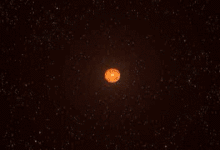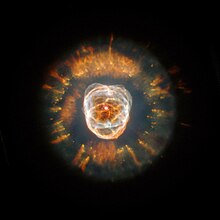Planetarna maglina

Planetarna maglina je emisiona maglina koja se sastoji od svetlećeg jonizovanog gasa koji se širi.[1] Ime je dobila zbog sličnosti sa izgledom planeta kada se posmatra kroz manji teleskop, ali nema nikakve veze sa planetama Sunčevog sistema.[2][3] One su relativno kratkotrajan fenomen, samo nekoliko desetina hiljada godina, u odnosu na tipični stelarni životni vek od nekoliko milijardi godina.
Posmatranja[uredi | uredi izvor]

Planetarne magline su relativno tamni objekti i prividno mali objekti. Ni jedna nije vidljiva golim okom. Prva otkrivena planetarna maglina je bila Mesje 27 koju je otkrio Šarl Mesje 1764. godine. Posmatrane tadašnjim slabim i nesavršenim teleskopima, planetarne magline donekle su ličile na gasovite planete, posebin Uran i Neptun. Vilhelm Heršel, otkrivač Urana, uveo je naziv planetarna maglina u upotrebu. Naziv se zadržao do danas uprkos tome što se zna da su planetarne magline veoma različite od planeta.
Upotrebom spektroskopskih metoda u 19. veku počela se otkrivati narav planetarnih maglina. Pionir spektroskopije Vilijam Hagins prvi je počeo sa sistematskim posmatranjem različitih objekata. Njegova proučavanja zvezda otkrila su da one imaju kontinuirani spektar ispresecan mnogim tamnim linijama. Kasnije je otkrio da mnoge magline poput galaksije Andromede imaju spektar sličan zvezdama.
Kada je Hagins usmerio teleskop prema NGC 6543 (poznatoj i pod imenom maglina Mačje oko), uočio je znatno drugačiji spektar. Umesto kontinuiranog spektra otkrio je spektar sa malim brojem emisionih linija. Najsjajnija od tih linija bila je ona s talasnom dužinom od 500,7 nm koja nije odgovarala niti jednom tada poznatom elementu. Astronomi su te linije pripisali nepoznatom elementu kojeg su nazvali nebulijum. Na sličan je način otkriven i helijum prilikom spektroskopskih posmatranja Sunca.
Naučnici su uskoro uspeli da izoluju helijum na Zemlji ali ne i nebulijum. Uskoro su neki naučnici na početku 20. veka pretpostavili da emisiona linija od 500,7 nm odgovara poznatom elementu u nepoznatim uslovima.
Napredak fizike i izvršavanje određenih eksperimenata pokazalo je da linija od 500,7 nm odgovara dvostruko jonizovanom kiseoniku (O2+ ili OIII). Kako je takva jonizacija moguća samo u veoma retkom gasu to je bio direktan dokaz da se od takvog gasa sastoje planetarne magline. Spektroskopska posmatranja pokazala su i da se sve planetarne magline polagano šire.
Središte zvezda planetarnih maglina su veoma vruće ali i relativno tamno, što govori da su veoma male. Pokazalo da su te zvezde zapravo beli patuljci, užarena jezgra nekadašnjih zvezda.
Galerija[uredi | uredi izvor]
Reference[uredi | uredi izvor]
- ^ Frankowski & Soker 2009, str. 654–8
- ^ Kwok 2005, str. 271–8
- ^ Hubblesite.org 1997
Literatura[uredi | uredi izvor]
- Aller, Lawrence H.; Hyung, Siek (2003), Kwok, Sun; Dopita, Michael; Sutherland, Ralph, ur., „Historical Remarks on the Spectroscopic Analysis of Planetary Nebulae (invited review)”, Proceedings of the 209th Symposium of the International Astronomical Union, Planetary Nebulae: Their Evolution and Role in the Universe, Canberra, Australia: Astronomical Society of the Pacific, 209: 15, Bibcode:2003IAUS..209...15A
- Allison, Mark (2006), Star clusters and how to observe them, Birkhäuser, str. 56—8, ISBN 978-1-84628-190-7
- Bowen, I. S. (oktobar 1927), „The Origin of the Chief Nebular Lines”, Publications of the Astronomical Society of the Pacific, 39: 295—7, Bibcode:1927PASP...39..295B, doi:10.1086/123745
- Frankowski, Adam; Soker, Noam (novembar 2009), „Very late thermal pulses influenced by accretion in planetary nebulae”, New Astronomy, 14 (8): 654—8, Bibcode:2009NewA...14..654F, doi:10.1016/j.newast.2009.03.006, „A planetary nebula (PN) is an expanding ionized circumstellar cloud that was ejected during the asymptotic giant branch (AGB) phase of the stellar progenitor.”
- Gurzadyan, Grigor A. (1997), The Physics and dynamics of planetary nebulae, Springer, ISBN 978-3-540-60965-0
- Harpaz, Amos (1994), Stellar Evolution, A K Peters, Ltd., ISBN 978-1-56881-012-6
- Hora, Joseph L.; Latter, William B.; Allen, Lori E.; Marengo, Massimo; Deutsch, Lynne K.; Pipher, Judith L. (septembar 2004), „Infrared Array Camera (IRAC) Observations of Planetary Nebulae”, Astrophysical Journal Supplement Series, 154 (1): 296—301, Bibcode:2004ApJS..154..296H, doi:10.1086/422820
- Hubble Witnesses the Final Blaze of Glory of Sun-Like Stars, Hubblesite.org, 17. 12. 1997, Arhivirano iz originala 01. 04. 2010. g., Pristupljeno 9. 8. 2008
- Huggins, W.; Miller, W. A. (1864), „On the Spectra of some of the Nebulae”, Philosophical Transactions of the Royal Society of London, 154: 437—44, Bibcode:1864RSPT..154..437H
- Iliadis, Christian (2007), Nuclear physics of stars. Physics textbook, Wiley-VCH, str. 18,439—42, ISBN 978-3-527-40602-9
- Jacoby, George. H.; Ferland, Gary. J.; Korista, Kirk T. (2001), „The Planetary Nebula A39: An Observational Benchmark for Numerical Modeling of Photoionized Plasmas”, The Astrophysical Journal, 560 (1): 272—86, Bibcode:2001ApJ...560..272J, doi:10.1086/322489
- Jordan, S.; Werner, K.; O'Toole, S. J. (mart 2005), „Discovery of magnetic fields in central stars of planetary nebulae”, Astronomy & Astrophysics, 432 (1): 273—9, Bibcode:2005A&A...432..273J, doi:10.1051/0004-6361:20041993
- Kiss, L. L.; Szabó, Gy. M.; Balog, Z.; Parker, Q. A.; Frew, D. J. (novembar 2008), „AAOmega radial velocities rule out current membership of the planetary nebula NGC 2438 in the open cluster M46”, Monthly Notices of the Royal Astronomical Society, 391 (1): 399—404, Bibcode:2008MNRAS.391..399K, doi:10.1111/j.1365-2966.2008.13899.x
- Krause, Arthur (1961), Astronomy, Oliver and Boyd, str. 187
- Kwok, Sun (2000), The origin and evolution of planetary nebulae, Cambridge University Press, ISBN 978-0-521-62313-1 (Chapter 1 can be downloaded here.)
- Kwok, Sun (jun 2005), „Planetary Nebulae: New Challenges in the 21st Century”, Journal of the Korean Astronomical Society, 38 (2): 271—8, Bibcode:2005JKAS...38..271K, doi:10.5303/JKAS.2005.38.2.271
- Kwok, Sun; Su, Kate Y. L. (decembar 2005), „Discovery of Multiple Coaxial Rings in the Quadrupolar Planetary Nebula NGC 6881”, The Astrophysical Journal, 635 (1): L49—52, Bibcode:2005ApJ...635L..49K, doi:10.1086/499332, „We report the discovery of multiple two-dimensional rings in the quadrupolar planetary nebula NGC 6881. As many as four pairs of rings are seen in the bipolar lobes, and three rings are seen in the central torus. While the rings in the lobes have the same axis as one pair of the bipolar lobes, the inner rings are aligned with the other pair. The two pairs of bipolar lobes are likely to be carved out by two separate high-velocity outflows from the circumstellar material left over from the asymptotic giant branch (AGB) wind. The two-dimensional rings could be the results of dynamical instabilities or the consequence of a fast outflow interacting with remnants of discrete AGB circumstellar shells.”
- Kwok, Sun; Koning, Nico; Huang, Hsiu-Hui; Churchwell, Edward (2006), Barlow, Roberto H.; Méndez, Michael J., ur., „Planetary nebulae in the GLIMPSE survey”, Proceedings of the International Astronomical Union, Symposium #234, Planetary Nebulae in our Galaxy and Beyond, Cambridge: Cambridge University Press, 2 (S234): 445—6, Bibcode:2006IAUS..234..445K, doi:10.1017/S1743921306003668, „Planetary nebulae (PNs) have high dust content and radiate strongly in the infrared. For young PNs, the dust component accounts for ∼1/3 of the total energy output of the nebulae (Zhang & Kwok 1991). The typical color temperatures of PNs are between 100 and 200 K, and at λ >5 μm, dust begins to dominate over bound-free emission from the ionized component. Although PNs are traditionally discovered through examination of photographic plates or Hα surveys, PNs can also be identified in infrared surveys by searching for red objects with a rising spectrum between 4-10 μm.”
- Liu, X.-W.; Storey, P. J.; Barlow, M. J.; Danziger, I. J.; Cohen, M.; Bryce, M. (mart 2000), „NGC 6153: a super–metal–rich planetary nebula?”, Monthly Notices of the Royal Astronomical Society, 312 (3): 585—628, Bibcode:2000MNRAS.312..585L, doi:10.1046/j.1365-8711.2000.03167.x
- Maciel, W. J.; Costa, R. D. D.; Idiart, T. E. P. (oktobar 2009), „Planetary nebulae and the chemical evolution of the Magellanic Clouds”, Revista Mexicana de Astronomía y Astrofísica, 45: 127—37, Bibcode:2009RMxAA..45..127M, „These objects are produced by low and intermediate mass stars, with main sequence masses roughly between 0.8 and 8 M⊙, and present a reasonably large age and metallicity spread.”
- Majaess, D. J.; Turner, D.; Lane, D. (decembar 2007), „In Search of Possible Associations between Planetary Nebulae and Open Clusters”, Publications of the Astronomical Society of the Pacific, 119 (862): 1349—60, Bibcode:2007PASP..119.1349M, doi:10.1086/524414
- Marochnik, L.S.; Shukurov, Anwar; Yastrzhembsky, Igor (1996), „Chapter 19: Chemical abundances”, The Milky Way galaxy, Taylor & Francis, str. 6—10, ISBN 978-2-88124-931-0
- Mermilliod, J.-C.; Clariá, J. J.; Andersen, J.; Piatti, A. E.; Mayor, M. (avgust 2001), „Red giants in open clusters. IX. NGC 2324, 2818, 3960 and 6259”, Astronomy and Astrophysics, 375 (1): 30—9, Bibcode:2001A&A...375...30M, doi:10.1051/0004-6361:20010845
- Moore, S. L. (oktobar 2007), „Observing the Cat's Eye Nebula”, Journal of the British Astronomical Association, 117 (5): 279—80, Bibcode:2007JBAA..117R.279M
- Morris, M. (1990), „Bipolar asymmetry in the mass outflows of stars in transition”, Ur.: Mennessier, M.O.; Omont, Alain, From Miras to planetary nebulae: which path for stellar evolution?, Montpellier, France, September 4–7, 1989 IAP astrophysics meeting: Atlantica Séguier Frontières, str. 526—30, ISBN 978-2-86332-077-8
- Osterbrock, Donald E.; Ferland, G. J. (2005), Ferland, G. J., ur., Astrophysics of gaseous nebulae and active galactic nuclei, University Science Books, ISBN 978-1-891389-34-4
- Parker, Quentin A.; Acker, A.; Frew, D. J.; Hartley, M.; Peyaud, A. E. J.; Ochsenbein, F.; Phillipps, S.; Russeil, D.; Beaulieu, S. F. (novembar 2006), „The Macquarie/AAO/Strasbourg Hα Planetary Nebula Catalogue: MASH”, Monthly Notices of the Royal Astronomical Society, 373 (1): 79—94, Bibcode:2006MNRAS.373...79P, doi:10.1111/j.1365-2966.2006.10950.x
- Reed, Darren S.; Balick, Bruce; Hajian, Arsen R.; Klayton, Tracy L.; Giovanardi, Stefano; Casertano, Stefano; Panagia, Nino; Terzian, Yervant (novembar 1999), „Hubble Space Telescope Measurements of the Expansion of NGC 6543: Parallax Distance and Nebular Evolution”, Astronomical Journal, 118 (5): 2430—41, Bibcode:1999AJ....118.2430R, doi:10.1086/301091
- Renzini, A. (1987), S. Torres-Peimbert, ur., „Thermal pulses and the formation of planetary nebula shells”, Proceedings of the 131st symposium of the IAU: 391—400, Bibcode:1989IAUS..131..391R
- Soker, Noam (februar 2002), „Why every bipolar planetary nebula is `unique'”, Monthly Notices of the Royal Astronomical Society, 330 (2): 481—6, Bibcode:2002MNRAS.330..481S, doi:10.1046/j.1365-8711.2002.05105.x
- The first detection of magnetic fields in the central stars of four planetary nebulae, SpaceDaily Express, 6. 1. 2005, Pristupljeno 18. 10. 2009, „Source: Journal Astronomy & Astrophysics”
Spoljašnje veze[uredi | uredi izvor]
- Entry in the Encyclopedia of Astrobiology, Astronomy, and Spaceflight
- Press release on recent observations of the Cat's Eye Nebula
- Planetary Nebulae, SEDS Messier Pages
- The first detection of magnetic fields in the central stars of four planetary nebulae
- Planetary Nebulae—Information and amateur observations
- Planetary nebula on arxiv.org







